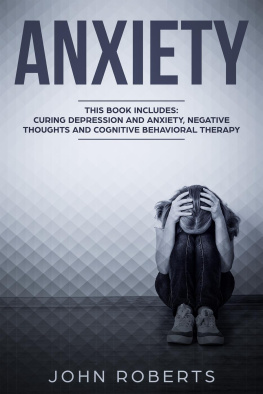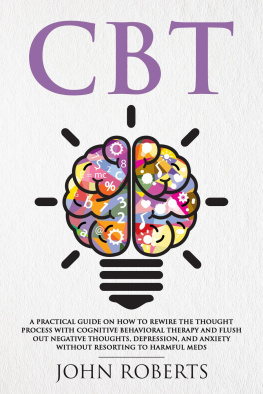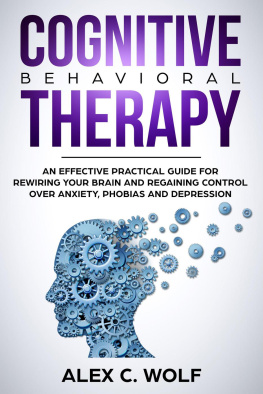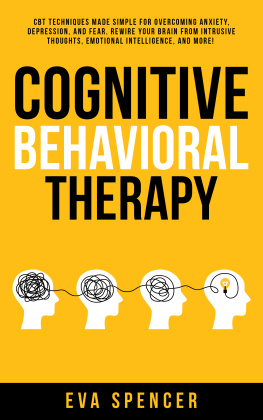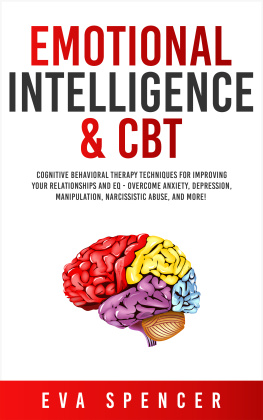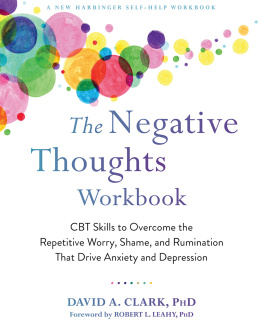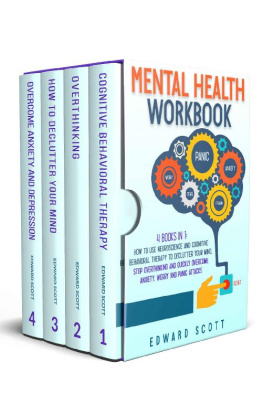Cognitive Behavioral Therapy
How to Rewire the Thought Process and Flush out Negative Thoughts, Depression, and Anxiety, Without Resorting to Harmful Meds
John Roberts
I want to thank you and congratulate you for downloading the book, Cognitive Behavioral Therapy: How to Rewire the Thought Process and Flush out Negative Thoughts, Depression, and Anxiety, Without Resorting to Harmful Meds.
People that have suffered from depression, anxiety, or constant negative thoughts, know how difficult it can be to break this vicious, apparently never-ending cycle. The majority of sufferers from these illnesses usually end up taking medications that can have very drastic negative consequences over the short or long-term. Cognitive Behavioral Therapy has been a practice applied with a great degree of success over several decades now. Patients that apply CBT principles to their lives are able to avoid medication or gradually decrease it as you get a better grasp on the methods used. Despite being a specialized approach that takes experienced individuals to administer, CBT can still be practiced on your own.
Interestingly, one of the main goals of CBT is to enable patients to become practitioners themselves. Over the long course, Cognitive Behavioral Therapy aims to train patients to diagnose, treat, and condition themselves to overcome the symptoms of their stress and depression.
Here, you will discover how CBT works and how to use it in your own personal setting. You will be covering a few techniques that many therapists and patients use to zero in on their psychological problems and how to get through them.
Please read this book from start to finish, as it is designed to introduce you to the method and walk you through the various techniques that embody the approach. Without working knowledge of the underlying principles at work, your results become hard to predict and achieve.
Another thing to note about the techniques here is that they are meant to be learned and mastered after a set time. The ultimate goal of CBT is to inspire complete independence from medication and therapy, turning the patient into an expert on themselves.
When achieved, you will no longer need this manual and its contents to deal with your anxiety and depression should you experience resurgence and relapses of your symptoms. On top of that, you will also be able to stand as a guide for those who are also seeking comfort and treatment.
Copyright 2017 by John Roberts - All rights reserved.
This document is geared towards providing exact and reliable information in regards to the topic and issue covered. The publication is sold with the idea that the publisher is not required to render accounting, officially permitted, or otherwise, qualified services. If advice is necessary, legal or professional, a practiced individual in the profession should be ordered.
- From a Declaration of Principles which was accepted and approved equally by a Committee of the American Bar Association and a Committee of Publishers and Associations.
In no way is it legal to reproduce, duplicate, or transmit any part of this document in either electronic means or in printed format. Recording of this publication is strictly prohibited and any storage of this document is not allowed unless with written permission from the publisher. All rights reserved.
The information provided herein is stated to be truthful and consistent, in that any liability, in terms of inattention or otherwise, by any usage or abuse of any policies, processes, or directions contained within is the solitary and utter responsibility of the recipient reader. Under no circumstances will any legal responsibility or blame be held against the publisher for any reparation, damages, or monetary loss due to the information herein, either directly or indirectly.
Respective authors own all copyrights not held by the publisher.
The information herein is offered for informational purposes solely, and is universal as so. The presentation of the information is without contract or any type of guarantee assurance.
The trademarks that are used are without any consent, and the publication of the trademark is without permission or backing by the trademark owner. All trademarks and brands within this book are for clarifying purposes only and are the owned by the owners themselves, not affiliated with this document.
Chapter 1: CBT Simplified
I f youre suffering from depression or know someone who is, theres a large chance youve already heard of Cognitive Behavioral Therapy (CBT). It goes along the line of many advanced therapy methods that are aimed to reduce symptoms and improve the quality of life.
This approach has been around for quite some time, even before the industrial era. It has gone through eras of changes in medical and technological developments. Surprisingly, its still one of the most widely-used methods to deal with many psychological disorders. That fact alone should attest to how effective it is.
In a nutshell, CBT focuses on empowering your mind to notice erroneous thought patterns which cause negative emotions. In turn, these emotions lead to negative behavior, empowering the cycle of depression and anxiety.
BASIC MODEL
Every activity and method under CBT revolves around the notion that our thoughts, emotions and behaviors share a very special bond. This bond becomes very powerful for someone suffering from depression.
When someone starts harboring negative thoughts about themselves and the way they perceive the world, it tends to bring about certain emotions. Take, for instance, a depressed person.
These people are predisposed to think that theyre not worth a lot of attention. Their thoughts revolve around the notion that they are people of very little value and whatever bad things happen to them, they probably deserve it.
Living under this false pretense, people will tend to harbor intense sadness and helplessness about their disposition in life. If you think that youre not worth the trouble, why still live?
This intense grief and sadness can push someone over the brink. This is why depression is one of the leading causes of suicide all around the world. That is one of the reasons why CBT saves thousands of lives almost everyday.
THOUGHTS -> EMOTIONS -> BEHAVIOR
This is why the method is called Cognitive Behavioral Therapy. It deals with fixing the way you think to change the way you feel. When youve changed the way you feel, your behavior changes as well.
Put this model in reverse and the logic is still sound. You wouldnt think less of yourself if youre full of positive thoughts. If your state of mind is calm and clear, youll have very little reason to fuel negative emotions.
Next page







